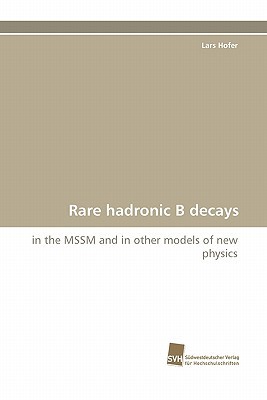
- We will send in 10–14 business days.
- Author: Lars Höfer
- Publisher: Sudwestdeutscher Verlag Fur Hochschulschriften AG
- Year: 2011
- Pages: 148
- ISBN-10: 3838124731
- ISBN-13: 9783838124735
- Format: 15.2 x 22.9 x 0.9 cm, softcover
- Language: English
- SAVE -10% with code: EXTRA
Reviews
Description
The study of rare hadronic B decays at LHCb and at the planned Super-B factories is a valueable tool in the search for new physics. The variety of hadronic decay channels allows for over-constraining measurements of flavour-changing neutral currents. The author discusses several aspects of new physics in rare hadronic B decays. In the first part of the book, the Minimal Supersymmetric Standard Model (MSSM) with Minimal Flavor Violation is analysed. In this model, large effects can occur in rare B decays due to tan(beta)-enhanced corrections which have to be resummed to all orders. The known resummation formulae are generalised beyond the decoupling limit and novel effects in couplings involving genuine supersymmetric particles are studied. In the second part of the book, the possibility of probing new physics in electroweak penguins via hadronic B decays is discussed. Such kind of new physics is suggested by puzzling data in B K, pi decays. The author shows that a measurement of the purely isospin-violating decays Bs phi, pi(rho) could shed light on this puzzle. A model-independent study and a study of concrete well-motivated new physics scenarios are performed.
EXTRA 10 % discount with code: EXTRA
The promotion ends in 20d.02:57:14
The discount code is valid when purchasing from 10 €. Discounts do not stack.
- Author: Lars Höfer
- Publisher: Sudwestdeutscher Verlag Fur Hochschulschriften AG
- Year: 2011
- Pages: 148
- ISBN-10: 3838124731
- ISBN-13: 9783838124735
- Format: 15.2 x 22.9 x 0.9 cm, softcover
- Language: English English
The study of rare hadronic B decays at LHCb and at the planned Super-B factories is a valueable tool in the search for new physics. The variety of hadronic decay channels allows for over-constraining measurements of flavour-changing neutral currents. The author discusses several aspects of new physics in rare hadronic B decays. In the first part of the book, the Minimal Supersymmetric Standard Model (MSSM) with Minimal Flavor Violation is analysed. In this model, large effects can occur in rare B decays due to tan(beta)-enhanced corrections which have to be resummed to all orders. The known resummation formulae are generalised beyond the decoupling limit and novel effects in couplings involving genuine supersymmetric particles are studied. In the second part of the book, the possibility of probing new physics in electroweak penguins via hadronic B decays is discussed. Such kind of new physics is suggested by puzzling data in B K, pi decays. The author shows that a measurement of the purely isospin-violating decays Bs phi, pi(rho) could shed light on this puzzle. A model-independent study and a study of concrete well-motivated new physics scenarios are performed.


Reviews